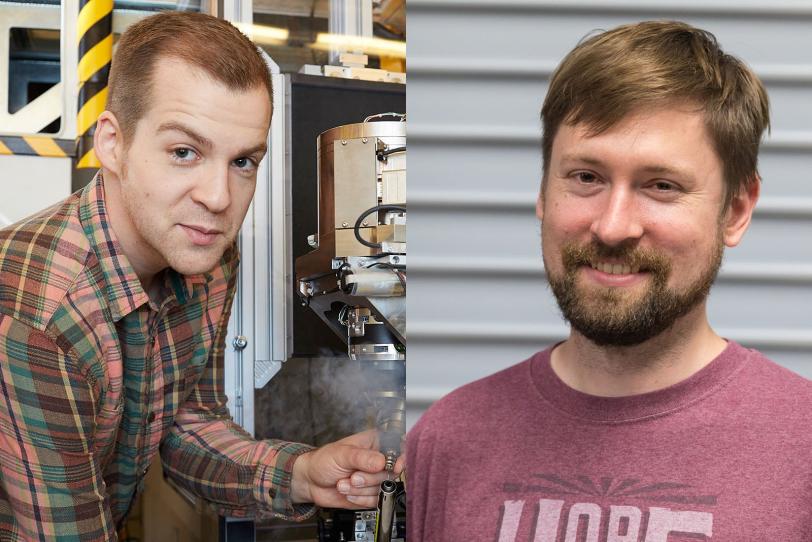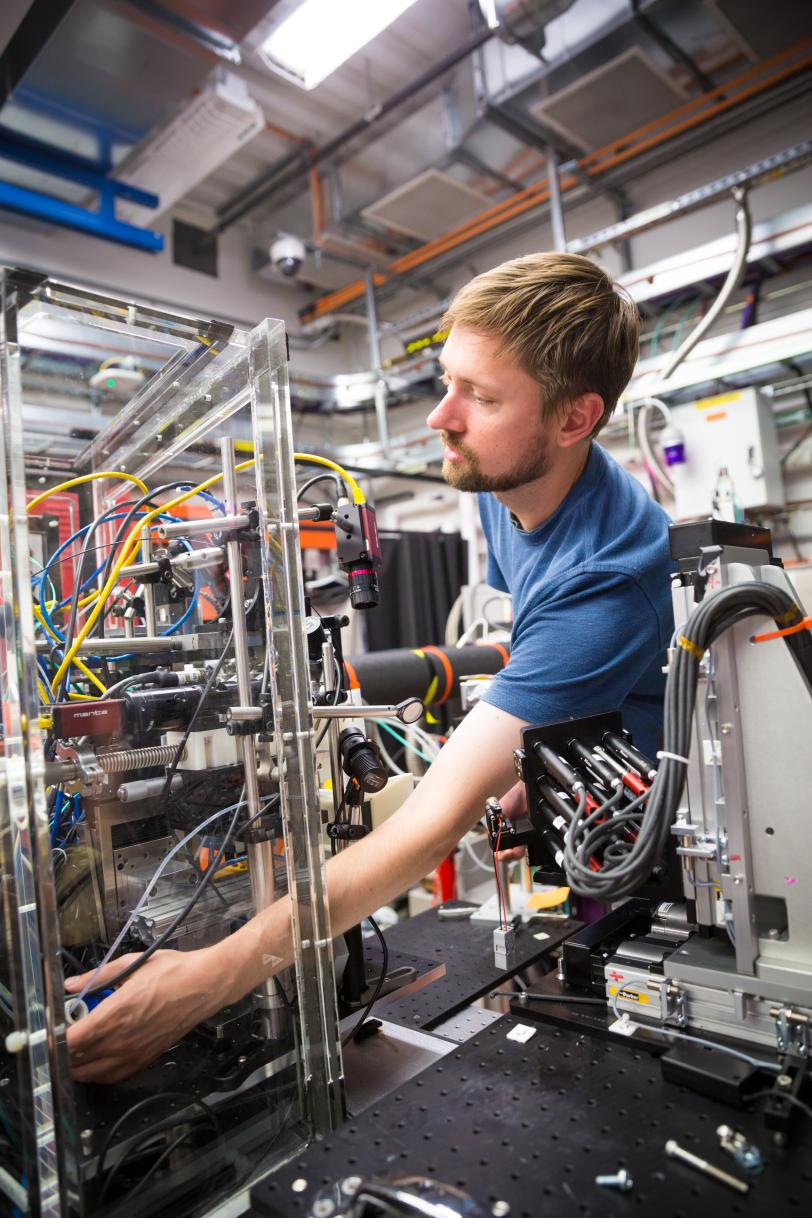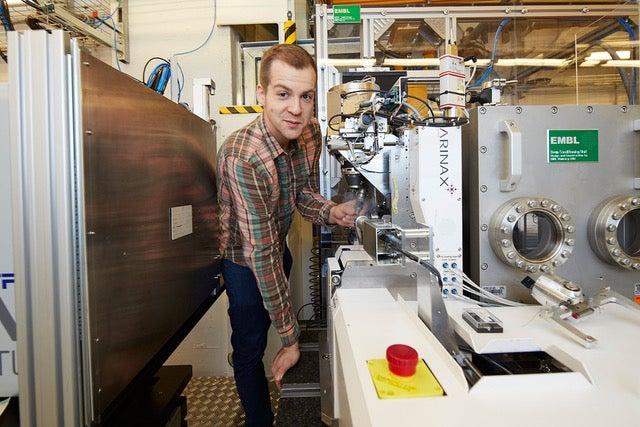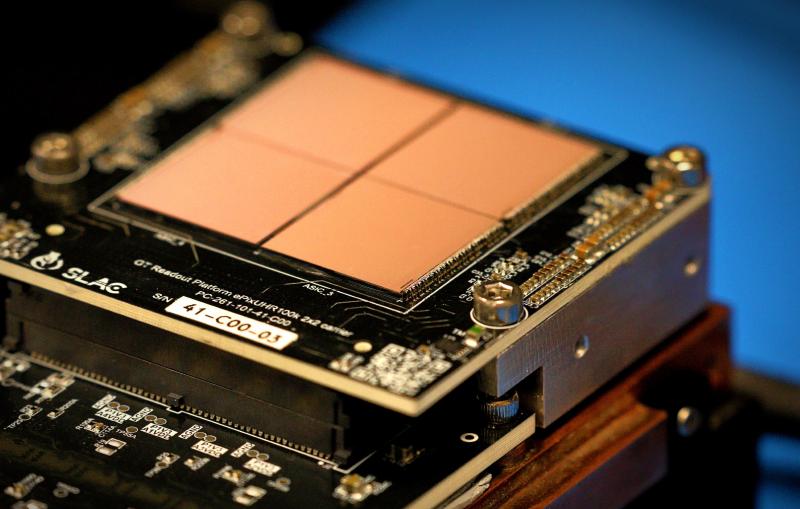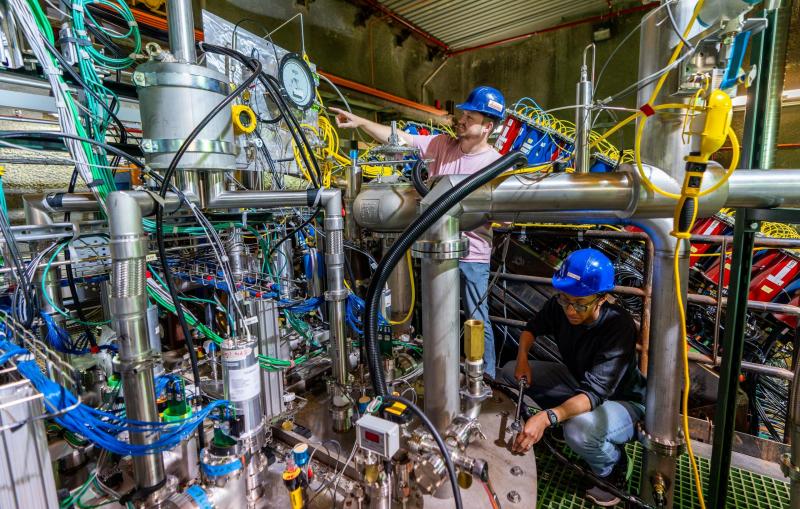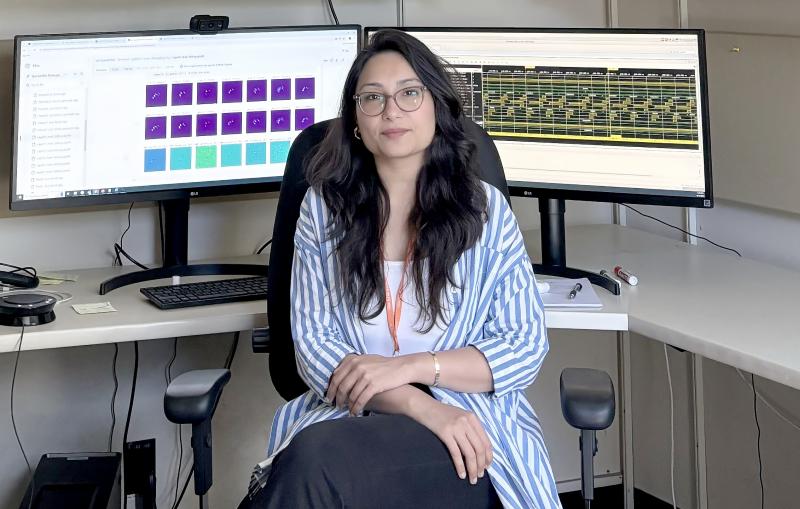Franklin Fuller and Cornelius Gati Named 2017 Panofsky Fellows at SLAC
Over the next five years they’ll work on getting significantly more information about how catalysts work and improving biological imaging methods.
By Manuel Gnida and Amanda Solliday
Franklin Fuller and Cornelius Gati have been awarded 2017 Panofsky Fellowships by the Department of Energy’s SLAC National Accelerator Laboratory, where they will work over the next five years to get significantly more information about how catalysts work and develop new and improved biological imaging methods.
The fellowship honors Wolfgang K. H. Panofsky, the lab’s founding director, and is awarded to exceptional and promising young scientists who would most benefit from the unique opportunity to conduct their research at the lab. Panofsky fellows receive generous research support that includes funding for a postdoctoral researcher, and are eligible for continuing appointment at SLAC.
Mining Big Data to Understand Catalysts
Fuller wants to untangle complexities in the large amounts of data collected during experiments at X-ray free-electron lasers (XFELs).
As a postdoctoral researcher at Lawrence Berkeley National Laboratory, Fuller has conducted biochemistry research at SLAC’s XFEL, the Linac Coherent Light Source (LCLS), a DOE Office of Science User Facility.
For the past three years, he focused on spectroscopy studies with X-ray lasers that examine the interaction of light with molecules and atoms in catalysts, which are used to promote chemical reactions.
During that time, he began to apply machine learning to understand the large amounts of data that scientists must sift through to understand such experiments. In these studies, samples are illuminated with rapid laser pulses and then probed with the XFEL up to 120 times per second, and each XFEL pulse generates its own set of information.
When the X-ray light passes through the sample, its “color” or energy can change. By comparing the color of the X-ray light entering and leaving the sample, scientists can infer some of the sample’s properties.
“X-ray lasers have these chaotic pulses that may be a very different energy from pulse to pulse,” Fuller says. “So you measure millions of pulses before and after they interact with a sample, and then run it through an algorithm to reconstruct what happened in the middle.”
LCLS-II—the next generation of SLAC’s X-ray laser—will generate even more frequent pulses, up to a million light pulses per second. The rapid laser pulses will allow scientists to more reliably capture rare events that may be missed during less frequent probing. This will require advanced data analysis techniques, such as machine learning, to handle the volume of information.
“Franklin’s work is at the forefront of what scientists want to be able to do with X-ray free-electron lasers,” says Junko Yano, a senior scientist at Berkeley Lab who advised Fuller during his postdoctoral fellowship.
Fuller’s proposal for the fellowship included a research outline for “multidimensional spectroscopy” that would allow scientists to interpret signals obtained by hitting samples with X-ray light of two or three colors at once in multiple color combinations. This would allow them to directly probe correlations between atoms in the molecule.
During the Panofsky fellowship, Fuller plans to look closely at artificial solar fuel catalysts, such as perovskites. Many candidate catalysts are made from a combination of multiple metals and organic atoms.
“These systems—although fairly simple molecularly—are quite complex in their internal interactions,” Fuller says. “You don’t always get the sum of the parts in chemical mixtures. There’s some new stuff because they’re interacting with each other.”
Multidimensional spectroscopy would allow Fuller and other researchers to closely examine these interactions—how electrons move between the individual components—to better engineer the material.
Fuller began studying complex electronic structure of catalysts as PhD student at the University of Michigan. He was able to use multidimensional spectroscopy to study photosynthesis, where light is harvested to create energy. To do this, he developed multidimensional spectroscopy methods with visible light, and now he would like to adapt the same concept for X-ray research.
“This hasn’t been done with X-rays,” says Berkeley Lab senior scientist Vittal Yachandra, who also advised Fuller as a postdoc. “There’s a real gap in knowledge, and he fills that gap beautifully.”
Making Sharper Images of Life’s Molecules
For Gati, the ultimate research goal is to be able to take atomic-resolution images of biomolecules inside living cells and organisms. Such superior views can provide information about how a protein is functioning within its native environment. This is valuable for understanding basic biology and could help better determine how the structures of enzymes, receptors and other proteins are tied to key functions of bacteria, archaea, viruses, plants and animals. It can also advance efforts to predict how microbial communities respond to changes in their environments, produce biofuels and other useful bioproducts, understand disease and develop new drugs and therapies.
“I want to push the limits of the imaging techniques currently available in structural biology,” Gati says. “We can already obtain atomic-resolution images of biomolecules when we isolate them, but our vision is somewhat blurred when the molecules are in their native environments.”
Gati says he intends to develop groundbreaking methods for structural biology that use state-of-the-art XFELs, such as SLAC’s LCLS, and cryo-electron microscopes (cryoEM), which are now being installed at the lab as part of a joint initiative on cryoEM between SLAC and Stanford University.
“SLAC is a unique place to pursue this research. The lab is already at the forefront of XFEL science, and it plans to become a world leader in cryoEM,” he says. “The Panofsky fellowship is a great opportunity to work in this stimulating environment, to interact with the many scientists who come to SLAC’s cutting-edge facilities, and to collaborate with experts within the multifaceted Stanford and SLAC communities.”
Gati’s research proposal encompasses three projects that aim to improve images obtained with X-rays and electrons.
The first one will label biomolecules with heavy atoms to improve the resolution of electron tomography – a method that allows researchers to explore the interior of objects in 3-D – from a few tens of a nanometer to less than a nanometer.
The second project, which also relies on heavy-atom labels, will look to improve the signal-to-noise ratio for imaging single particles with XFEL radiation and to push the capabilities of coherent X-ray diffractive imaging with XFEL pulses that are only a few femtoseconds, or millionths of a billionth of a second, long.
Finally, Gati hopes to overcome some of the current limitations to the resolution and information content of images made with electron microscopes by applying coherent diffractive imaging, which is mostly used at X-ray sources, to electrons.
“Cornelius’ unique strength is in developing new methods for both X-ray and electron beams,” says Soichi Wakatsuki, director of SLAC’s Biosciences Division. “His projects will bridge the research efforts of LCLS and the cryoEM initiative, and they are highly complementary to existing programs, including initiatives in single-particle imaging and ultrafast electron diffraction.”
Gati’s career began with training in molecular biology, cell biology and immunology. He received his bachelor’s degree from the German University of Tübingen and a master’s degree from the Technical University of Munich, both in biology.
“Initially I was using rather indirect techniques to study biomolecules that didn’t let me ‘see’ how things work on the molecular level,” he says. “That didn’t satisfy me, so I started out with X-ray crystallography, which allows studies of atomic structures.”
While working on his master’s thesis he heard about XFELs and their potential to one day enable atomic-level studies of single molecules. This inspired him to pursue his doctorate at the Center for Free-Electron Laser Science, a joint enterprise of the research center DESY, the Max Planck Society and the University of Hamburg in Germany. During that time he was a frequent visitor at LCLS.
In the meantime, the field of cryoEM saw a scientific boom, triggered by technological advances that led to enormous improvements in resolution and the accessibility of smaller biomolecules. Gati therefore decided to do postdoctoral research at the MRC Laboratory of Molecular Biology in the United Kingdom and to learn more about this method.
Since January 2017, Gati has been a postdoctoral researcher in Wakatsuki’s lab at the Stanford School of Medicine, where he has already begun working on the research projects that he’ll now dive into as a Panofsky fellow.
For questions or comments, contact the SLAC Office of Communications at communications@slac.stanford.edu.
SLAC is a multi-program laboratory exploring frontier questions in photon science, astrophysics, particle physics and accelerator research. Located in Menlo Park, Calif., SLAC is operated by Stanford University for the U.S. Department of Energy's Office of Science.
SLAC National Accelerator Laboratory is supported by the Office of Science of the U.S. Department of Energy. The Office of Science is the single largest supporter of basic research in the physical sciences in the United States, and is working to address some of the most pressing challenges of our time. For more information, please visit science.energy.gov.
